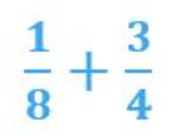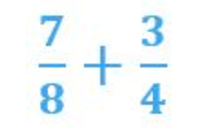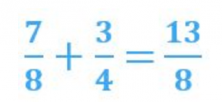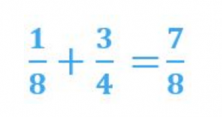In today’s post we’re going to learn how to add fractions, using something that I’m sure you know and love: Lego blocks!
They’ll help you understand the concept, just like the Singapore Method, and they’re also something that I’m sure you have at home. If not, you can draw your own, like the ones you’ll see below.
Arranging sums and understanding the process visually will help you add fractions much more quickly and easily!
If you have any blocks, get them ready before reading on. If you don’t have any, don’t worry! You’ll still be able to understand the rest of the post using the drawings we’ve provided.
If you need to remind yourself what proper and improper fractions are, read this post before continuing.
Example 1: Adding fractions to get a proper fraction as a result
You can start by working out the following addition:

Concentrate on the denominator of the fraction with the largest denominator, which is 8, and arrange 8 pieces to represent 1 unit:

Therefore, each piece will represent 1 eighth:

And 2 pieces will represent 1 quarter:

Now you can represent the fractions you want to add.
Using the yellow pieces to represent the “part” of the fraction (numerator) and the purple pieces to complete the unit and represent the “whole” (denominator), you can represent the sum like this:

Now separate all the pieces, so they all represent eighths:

Now put the pieces in a line, to represent the addition:

Finally, arrange the pieces, yellow first:

You’ve represented the result of the fraction! If you count the yellow pieces that you have, you’ll find that there are 7. Since each one represents one eighth, altogether they represent 7 eighths. Therefore, we’ve represented the addition:
Example 2: Adding fractions to get an improper fraction as a result
Now you’ve seen how we can add fractions to give a result of a proper fraction, you can try it with a sum that gives an improper fraction:

Just like before, represent the fractions that you want to add.

Separate all the pieces, so they represent eighths:

Put the pieces in a line:
![]()
And finally, arrange the pieces, yellow first:

Again, if you count the yellow pieces you have, you’ll find there are 13, and since each one represents an eighth, altogether they represent 13 eighths. Therefore, we’ve represented the addition:

See how easy it is to add fractions using Lego blocks to represent them? Share this post if you found it useful!
If you want to practice adding fractions, as well as other math exercises, register with Smartick and try it for free!
Learn More:
- Types of Fractions: Proper, Improper, Fractions Equal to One
- Practice Estimating Fractions with Examples
- Adding Fractions with Different Denominators
- Understanding Fractions: “If the Whole Is Made of 8 Parts, How Can I Have 11?”
- Understand What a Fraction Is and When It Is Used








